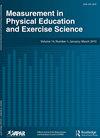Variable Height Step Test Provides Reliable Heart Rate Values During Virtual Cardiorespiratory Fitness Testing
IF 1.9
4区 教育学
Q2 EDUCATION & EDUCATIONAL RESEARCH
Measurement in Physical Education and Exercise Science
Pub Date : 2021-08-08
DOI:10.1080/1091367X.2021.1964507
引用次数: 0
Abstract
ABSTRACT The YMCA step test uses a prescribed step height which is difficult in a telehealth setting. Examine a modification of the YMCA step test allowing for the use of preexisting in-home objects of variable height as the “step” in a virtual environment. Young healthy participants (n = 40) performed step tests with a small and large object of their choosing within their home in a randomized cross-over study. The stepping frequency was modified for each step height using an established metabolic formula to match estimated exercising VO2 of the YMCA step test. Post-exercise self-palpated heart rate from the small (average 101 ± 23 BPM) vs large (103 ± 23 BPM) step tests were correlated (r = 0.865, p < .001) with good reliability (ICC = 0.865) and within-participant coefficient of variation of 6.8%. Modifying step frequency to account for the varying heights of objects used as “steps” results in reliable heart rate responses to the YMCA step test.可变高度步距测试在虚拟心肺健康测试中提供可靠的心率值
基督教青年会的步骤测试使用一个规定的步骤高度,这是难以在远程医疗设置。检查YMCA步骤测试的修改,允许使用预先存在的可变高度的家庭对象作为虚拟环境中的“步骤”。在一项随机交叉研究中,年轻健康的参与者(n = 40)在家中选择大小物体进行了步进测试。使用已建立的代谢公式修改每个台阶高度的行走频率,以匹配YMCA台阶测试的估计运动VO2。小步(平均101±23 BPM)与大步(103±23 BPM)的运动后自诊心率相关(r = 0.865, p < .001),信度良好(ICC = 0.865),参与者内变异系数为6.8%。修改步频,以考虑作为“步数”的物体的不同高度,从而在YMCA步数测试中获得可靠的心率反应。
本文章由计算机程序翻译,如有差异,请以英文原文为准。
求助全文
约1分钟内获得全文
求助全文
来源期刊

Measurement in Physical Education and Exercise Science
Medicine-Orthopedics and Sports Medicine
CiteScore
4.20
自引率
33.30%
发文量
24
期刊介绍:
The scope of Measurement in Physical Education and Exercise Science (MPEES) covers original measurement research, special issues, and tutorials within six substantive disciplines of physical education and exercise science. Six of the seven sections of MPEES define the substantive disciplines within the purview of the original research to be published in the journal: Exercise Science, Physical Activity, Physical Education Pedagogy, Psychology, Research Methodology and Statistics, and Sport Management and Administration. The seventh section of MPEES, Tutorial and Teacher’s Toolbox, serves to provide an outlet for review and/or didactic manuscripts to be published in the journal. Special issues provide an avenue for a coherent set of manuscripts (e.g., four to five) to collectively focus in-depth on an important and timely measurement-related issue within the scope of MPEES. The primary aim of MPEES is to publish high-impact manuscripts, most of which will focus on original research, that fit within the scope of the journal.
 求助内容:
求助内容: 应助结果提醒方式:
应助结果提醒方式:


